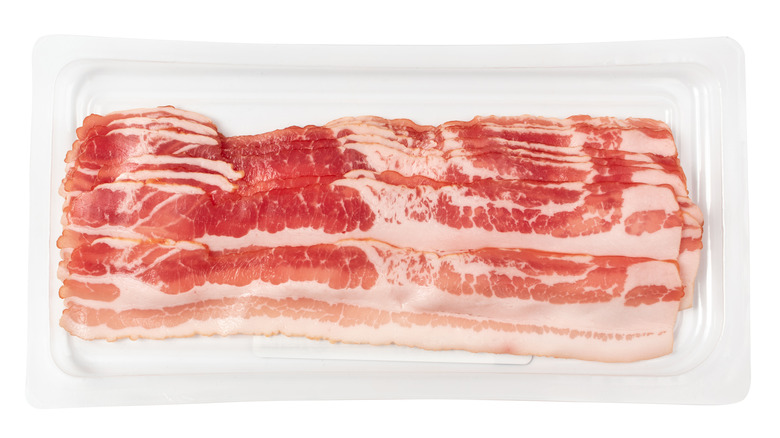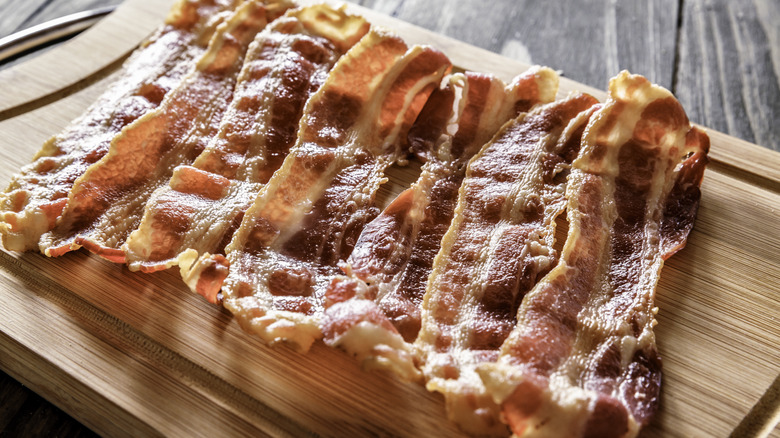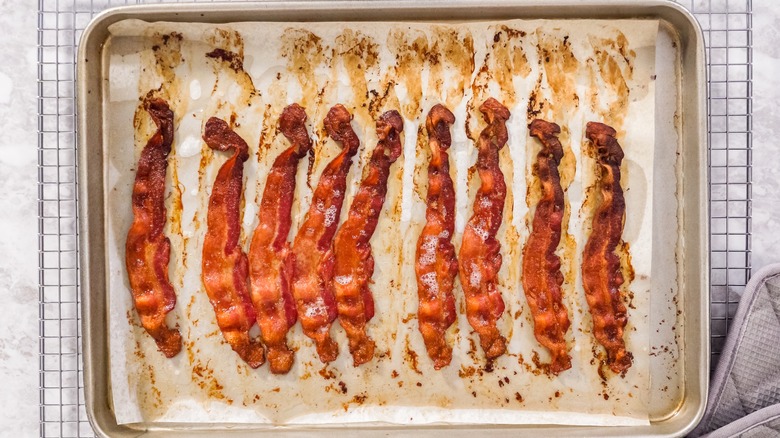The Easy Tip To Separate Your Bacon Without Stretching It
Despite the headlines you may come across online, there isn't a single "best" way to prepare bacon since the salty food is enjoyed in so many different ways. At one end of the extreme, people want their bacon practically raw, floppy, and chewy, while others prefer to cook it until it's burnt and the near color of charcoal. The one thing all bacon lovers can agree on, however, is the shared frustration of getting the meat out of the packaging intact.
When manufacturers vacuum seal the fatty protein, the slices bond together so intently it's like they're trying to reconnect. Even a gentle hand can stretch or tear the meat when trying to separate the slices, especially regular-sized bacon, which is only 1/16-inch thick. Luckily, there's an easy way to get the strips apart, whether you're cooking the entire pound or just need a slice or two to make a BLT sandwich.
First, before you attempt to separate the bacon, allow the package to come to room temperature (about 15 minutes). It's a mistake to cook cold bacon, and really this step doesn't add time to your prep, but it enables the cold fat to soften a bit, loosening its hold. Then, turn the package so the shorter end is closest to you, and roll the entire thing into a tube. The slices will separate easily once you open the package, eliminating the risk of uneven cooking due to stretching and tearing.
Tips for preparing crispy bacon
How you cook bacon may be dictated by how much you are preparing. If you're making less than a pound and love the strips crispy but still moist and tender, start cooking it in water. This foolproof technique works for all kinds of bacon thicknesses. The only downside is that you are limited to the largest skillet you have unless you want to dirty more than one pan. This cooking method prevents rubbery textured bacon, which is the result of the leaner parts burning before all the fat has been rendered (the water prevents the meat from burning as the fat melts). Once the water evaporates, you can cook the bacon to your desired doneness.
If you are preparing a big batch for a crowd, cooking bacon in the oven is the fastest method that still delivers delicious results. Arrange the room-temperature slices in a single layer on a parchment-lined sheet pan, and roast the bacon until the fat has rendered and is crispy. This technique is particularly helpful if you have other dishes to prepare since you don't need to flip or babysit the bacon as it cooks. Lining the sheet pan with parchment paper also makes cleanup a breeze and eliminates having to soak or scrub your pans afterward. Remember to strain and save the bacon grease to save your sink and add umami flavor to other recipes.
Storing leftover bacon
Since most manufacturers don't package bacon in resealable containers, you may need to decide whether to make the entire pound and reheat the leftovers later in the week, or store the uncooked bacon to prepare on another day. Luckily, you can successfully do it all without compromising the quality of the meat.
Once you open the package, which exposes the meat to air, you can safely store it in the refrigerator for up to one week. It's essential that you wrap the remaining package in foil, place it in a resealable plastic baggie, or use a vacuum food sealer to remove any excess air. If you don't plan on cooking the bacon in that timeframe, it can be frozen for up to four months.
If you prefer to cook all of the bacon and have leftovers, there's a way to reheat cooked bacon without drying it out. Remove the meat from the refrigerator and bring it to room temperature while you preheat the oven to 400 degrees Fahrenheit. This will limit the amount of time the slices spend in the oven. Bake them on a parchment-lined sheet pan for roughly six minutes, until you hear them start to sizzle. Remember that cooked bacon has a shorter shelf-life and should be eaten within four or five days.



